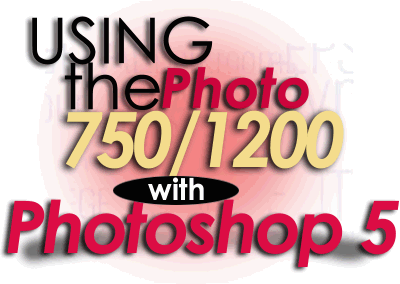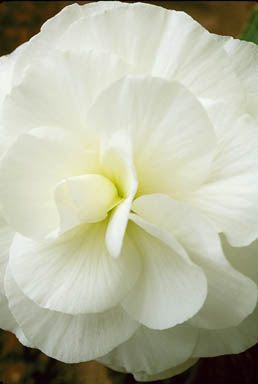System Colour Calibration
![]() April, 2000
April, 2000
This article is now a couple of years old and has become dated, as there are several new generations of printers as well as calibration tools available.
I now have a new article online calledMonitor Profiling and Calibrationwhich you will find to be more current and comprehensive than this one, though some of the information below is still useful for beginners. You’ll also find Ian Lyons’Computer Darkroomsite to be an excellent source of additional information on this topic.
For many years Mac owners had a serious advantage in their ability to calibrate their scanners, monitors and printers so that what-you-see-is-actually-what-you-get on your printer. Today, with Windows 98 and Photoshop 5 and later, mainstream computer users can have these same advantages.
Background
Anyone who has done traditional colour printing know how tedious and frequently frustrating achieving colour balance can be. Test print, change filters, … too light….test print… too magenta….test print… too green and too dark… change filters………. get me outa here.
When I moved to working with a computer image processing system in the mid-90’s I was overjoyed at how repeatable producing an image could be. But, getting what appeared on the slide to match what appeared on the screen, with what appeared on a print, was tedious at best and lacking in precision.
In the late summer of 1999 Iupgradedmy computer and digital imaging system again (I do so every couple of years) partially for greater speed, but in large measure to take advantage of recent improvements in accurate colour calibration. Today, most new operating systems, software and hardware comes with ICC/ICM colour profiles, which makes colour calibration relatively easy. (For Windows owners this makesWindows 98orWindows 2000virtually a must since ICM profiles do not always work inWindows 95).
In fact it is possible to use ICC/ICM profiles in WIN95 at the application and I/O level to get WYSIWYG all the way from scanner to monitor to printer. But, this requires an application that is ICM aware (Photoshop 5.0.2 or 5.5), a video board with colorLook-Up-Table capabilities and ADOBE Gamma (part of PhotoShop 5.0.2 or 5.5) or a monitor calibration package (likeColorblind’sProve it) withsoftware that can set the color LUT at system startup time.
I want to stress that unless you calibrate and profile your system so that what you see on the monitor is what prints on your printer, and do so with a high degree of accuracy, you’re just wasting your time in trying to do high-quality digital image processing.
There are some excellent books, articles and online resources on colour calibration. For example, there is an absolutely wonderful and comprehensive site calledAccurate Image Manipulation for Desktops. But, for many people this level of information is intimidating and confusing. I’m one of them. Another great resource is Andrew Rodney’sThe Digital Dog. But, the best and most easy to follow articles are found atDigitalDarkroom@Singapore. If you have an Epson 750/1200 printer then a must read article is……
 This graphic’s link is toIan Lyons‘page which contains this as well as other excellent digital darkroom articles inPDFformat.
This graphic’s link is toIan Lyons‘page which contains this as well as other excellent digital darkroom articles inPDFformat.
Where to Start
Firstly, before doing anything else, it’s important to get your monitor into basic shape. If you don’t do anything else at least do the following.
Photographed with a Nikon F4 and 60mm f/2.8 Micro-Nikkor
This photograph is one that I have been using for colour calibration for many years, both with chemical and digital systems. In the original transparency the white of the flower is very pure, with no colour cast. (The center of the flower is a soft yellow). As you can see here (hopefully) the light tonalities range from pure white down to medium gray. Judging colour purity on dark areas is difficult at best, while whites always show even the slightest colour casts. Click on the picture above orHEREto see the image in greater detail and to use it for setting your monitors contrast and brightness as well as color.

As a start, this step-wedge should be used to adjust your monitor’s brightness and contrast so that all 12 steps can be clearly differentiated. Next, look at the photograph above and adjust your monitor’s colour controls so that the flower is as white and free of colour casts as possible. This isn’t terribly scientific, but if you work carefully you can do a very credible job.
Calibration & Profiling
This section assumes that you’re using Windows 98 or later, PhotoShop 5.0 or later and an Epson Photo printer. The articles referenced above will give you much greater detail, but this is theCliffs Notesversion to get you underway.
Start by running theAdobe Gammautility which is found underHelp / Color Management. A word of caution though. If, like me, you have an LCD monitor rather than a regular CRT, following the instruction to turn contrast all the way up is a formula for frustration. Try 75% first.
A more sophisticated and preferable way to calibrate your monitor is to use a program likeColorblind’sProve it. This can be bought online from the publisher. I purchased mine fromInkjetmall.com. It’s available for $49.95, or together with a colorimeter for $250.00. If you useAdobe GammaorProve it!or any similar program without using a colorimeter the job that you do will only be as good as your own color judgment. A colorimeter is a small device that plugs into your serial or USB port and attaches to your monitor’s screen. It completely automates the calibration and profiling process.Without putting too fine a point on it‚ if you want to make prints that look like what you see on-screen, buy a software/hardware calibration package! (SeeMonitor Profiling and Calibrationfor more information).
Once the Gamma utility or calibration program likeProve it!is completed, save the profile. Go toControl Panel/Display/Settings/Advanced/Color Management and select the profile that you just created. I assume that your scanner can use an ICM monitor profile such as the one just created so when you go to use your scanner be sure that it also loads the right one. If your scanner does not use profiles, just ignore this (or consider upgrading).
Next, go intoPhotoShopand underFiles / Color Settings / RGB Setupset Adobe RGB 1998as your color space,Gammais set to 2.2 andWhite Pointto 6500 . Make sure thatDisplay Using Monitor Compensationis turned on .
Now, again underFiles / Color Settingsgo toProfile Setupand underAssumed Profilesset the box to read Adobe RGB 1998 .
That should do it for your monitor, scanner andPhotoShop. Now to the printer settings.
In PhotoShop go toFile / Page Setup / Properties / Advancedand setColor Managementto ICM . Set all of the other settings as you normally would. Now, when it’s time to print pressFile / Printand in theColor Spacebox select Epson Stylus 1270 (or whatever printer you’re using). SelectPrinter Color Managementon .
Creating Printer Profiles
OK. You’ve calibrated your monitor and profiled it. You now need to to profile your printer. (Profiling your scanner, if it’s a flat-bed, is included below. If you need to calibrate a film scanner this can get a lot more expensive). Hopefully your film scanner has come with aICM/ICCprofile from the manufacturer.
This is a vital step in color managing your whole system. If you only use one type of paper and one type of ink on one printer then possibly you might prefer to purchases a pre-made profile. But, if you expect to change your printer every year or two and you try different papers and inks as they come to market then being able to create your own profiles is very important.
There are a number of products available for printer profiling, butWiziWYGfromPraxisoftis the latest and least expensive. It costs only $79 and can be downloaded from the Net. A calibration target is needed as well and when you place your order it will be mailed to you.
Usage is very straightforward. You can download the manual but if you’d like to learn more the best thing to do is read theextensive write-upon using WiziWYG written byIan Lyons. There’s no point in my replicating his excellent work here again. Please also note that if you have a flat-bed scanner you can profile it as well, but in any eventyou must have a flatbed scanneras part of the printer profiling process with this product.
Clingmans DomeForest. Great Smoky Mountains NP. September, 2000
Photographed with a Hasselblad ArcBody and 45mm Rodenstock lens on Provia 100F.
Purchasing Custom Profiles
If you do not have a program for creating custom profiles you can still obtain them elsewhere or have them custom made for you. After some positive comments by one of our readers I ordered a custom printer profile fromInkjetMall.com. The one I ordered is for my favourite combination;Pictorico Hi-Gloss Filmwith Epson inks on anEpson Photo 1200printer.
It really makes a difference in print quality.But, not when you follow their instructions, at least with the profile that I ordered. If you happen to order the same profile ignore their recommended settings and instead selectbacklight film(which they do recommend),ICMand turn printer managementon. If you order a different profile for a different printer then you may have to do what I did, which is extensively experiment to find the right combination.
Inkjetmall.comshipped my order promptly, but I can’t say the same about their customer support. I called twice (including a call to their president) with some support issues, but weeks later I’m still waiting for a return call.
Printing Without Profiles
If you find that print colour are slightly off those seen on your monitor don’t be afraid to make adjustments on your printer settings. Go toFile / Page Setup / Properties / Advancedand selectColor Adjustmentinstead ofICM. You’ll still be using your profiles but will be able to make needed output adjustments. Use the sliders to set whatever colour correction is needed. A good way to judge this is withinPhotoshopwhere by adjustingColor Balanceon an test basis you can try and make the screen match the print.Then, use these values in setting the printer sliders.
Do some test prints. Once you’ve arrived at settings that produce prints matching your screen, just useSave Settingsto create a "setting profile"; for exampleCorrected Photo Paper, orCorrected Glossy Film. Then, the next time you print with that paper simple use that setting.
Why Epson Photo Printers are Preferred
There is a significant reason whyEpsonprinters appear to dominate the fine-art photography scene. AsGeorge Weddingpoints out in a recent article inDigital Camera Magazine, printers fromH-P,Canon,Lexmarkand others incorporate their printer nozzles into the ink cartridge. This means that using purchased or self-generated printing profiles, as we’ve been discussing on this page‚ would mean re-profiling each time a cartridge is changed.
Epsonprinters have the nozzles and print head built into the printer and thus changing ink cartridges does not change the subtle and very fine spray of coloured inks going onto the paper. This helps explain why there are countless third-party inks and profiles available forEpson’s Photoprinter line, and none for the other major printer manufacturers.
There’s a great deal of information on the net and in books and I urge you to read what’s out there. Color management is one of the more arcane aspects of desktop darkroom work, but once mastered it produces excellent and repeatable results.
Read this story and all the best stories on The Luminous Landscape
The author has made this story available to Luminous Landscape members only. Upgrade to get instant access to this story and other benefits available only to members.
Why choose us?
Luminous-Landscape is a membership site. Our website contains over 5300 articles on almost every topic, camera, lens and printer you can imagine. Our membership model is simple, just $2 a month ($24.00 USD a year). This $24 gains you access to a wealth of information including all our past and future video tutorials on such topics as Lightroom, Capture One, Printing, file management and dozens of interviews and travel videos.
- New Articles every few days
- All original content found nowhere else on the web
- No Pop Up Google Sense ads – Our advertisers are photo related
- Download/stream video to any device
- NEW videos monthly
- Top well-known photographer contributors
- Posts from industry leaders
- Speciality Photography Workshops
- Mobile device scalable
- Exclusive video interviews
- Special vendor offers for members
- Hands On Product reviews
- FREE – User Forum. One of the most read user forums on the internet
- Access to our community Buy and Sell pages; for members only.
















